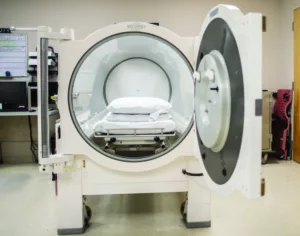
The BART Foundation aims to promote better outcomes for brain injury survivors by answering three questions – which alternative therapies are likely to work, where can they be found, and how can they be afforded? One of the ways we fulfill our mission is by carefully watching global research and clinical trial outcomes and sharing that information, in user-friendly language, with the TBI/ABI community. Hyperbaric oxygen therapy (HBOT) is one of the safe, alternative therapies the BART Foundation believes may help brain injury survivors. Perhaps if HBOT becomes more widely accepted as a treatment option, TBI/ABI/PCS survivors will be able to gain better access to this life-changing treatment.
We wanted to share segments of this recent article published in Pharmacy Times earlier last month. While the focus of the article is HBOT to help with healing from long COVID, there are many overlaps with the TBI/ABI community. Many thanks to Erin Hunter, Associate Editor of Pharmacy Times, for reporting on this vital topic.
Segments from the full article are excerpted below. Visit the Pharmacy Times website to read the entire piece.
Hyperbaric Oxygen Therapy May Be the First, Only Clinically Effective Treatment for Long COVID
Key Takeaways
- Hyperbaric Oxygen Therapy (HBOT) may be an effective treatment for long COVID, and it is the only therapy that has shown clinical effectiveness in a controlled clinical trial.
- The benefits of HBOT are durable, as it triggers neuroplasticity in the brain and may reverse brain damage caused by COVID infection.
- There are still many challenges in diagnosing and treating long COVID, as there are more than 200 symptoms associated with it (with most affecting the brain and nervous system), and many patients experience a delay in diagnosis or dismissal of symptoms.
After suddenly developing a series of severely debilitating neurological and physical disorders, Lynette Milakovich, a yoga teacher currently living in The Villages, Florida, spent almost 2 years and $20,000-plus on doctors’ appointments and failed therapies to treat her symptoms. It took nearly this duration of time before she learned the cause of her illness was long COVID-19 (long COVID), she told Pharmacy Times in a recent interview. It was not until receiving hyperbaric oxygen therapy (HBOT) treatment that she found lasting relief.
HBOT is currently the only treatment protocol that has been proven clinically effective in the treatment of long COVID in a controlled clinical trial, according to Shai Efrati, MD, the co-founder and chairman of the Medical Advisory Board to Aviv Scientific and director of the Sagol Center for Hyperbaric Medicine & Research at Shamir Medical Center, in an interview with Pharmacy Times.
Additionally, there are findings from a new longitudinal study published in Scientific Reports —which evaluated patient outcomes after 1 year of finishing an HBOT intervention— that show that the benefits sustained from HBOT might be long-term. According to Efrati. HBOT can repair brain tissue damaged by COVID-19, and this can actually lead to permanent changes.
“When we take care of the brain damage, it heals [the long COVID] symptoms,” Efrati told Pharmacy Times.
Long-Term Impact of HBOT for Patients With Long COVID
The purpose of HBOT is to increase oxygen absorption into the tissue, which can support brain injury recovery; it may be particularly effective for brain/CNS symptoms because it triggers brain neuroplasticity, or “the ability of the brain to repair itself,” Efrati explained. In essence, neuroplasticity enables the brain to reverse the damage and dysregulation caused by the virus.
Previous studies affirm these neuroplastic benefits in patients with stroke and traumatic brain injury who had improved cognitive and motor function and quality of life measures following HBOT. Findings from previous studies also show that HBOT creates positive microstructural changes in the brain.
However, no studies have evaluated the long-term clinical benefits associated with HBOT for patients with long COVID. In the present longitudinal study, 31 patients—having originally completed 40 sessions of HBOT the year prior at Aviv Clinics—filled out a series of questionnaires about quality of life, quality of sleep, and psychiatric and pain symptoms.
Patients were treated with hyperoxic-hypoxic paradox (HHP), an HBOT protocol that exposes the patient to fluctuating levels of elevated atmospheric pressure (compression/decompression rate of 1.0 m/min) and elevated oxygen (100% oxygen for 90 minutes with intermittent air breaks).
Based on the results, HBOT was found to be associated with persistent improvements in quality of life, quality of sleep, and psychiatric and pain symptoms. There was a moderate magnitude of improvement in neuropsychiatric symptoms (ie, depression, anxiety) and sleep quality that lasted long term, along with a significant reduction in pain and significant increase in quality of life at the time of analysis.
“[Although] I still have a bit of tinnitus, the rest of the symptoms are gone,” says Milakovich. “I have full cognition and feeling back… no more tremors and convulsions, no more PoTS.”
Prior to HBOT, Milakovich used various pharmacologic agents to try and treat symptoms individually: low-dose naltrexone for nerve pain/neuropathy, a nitric-oxide supplement (Cardio Miracle [manufactured by a brand of the same name]) for PoTs and tachyardia, and temazepam (Restoril; Mallinckrodt Pharmaceuticals) for insomnia. Milakovich also found anecdotal evidence supporting the use of other supplements like nattokinase (Cardiokinase; Plamed), curcumin, and bromelain for long COVID.
Efrati noted it may be worth trying different methods and treatments for long COVID, however, none offer evidence-based outcomes besides HBOT.
In time, Efrati believes that HBOT clinics will begin to create a multi-strategy treatment protocol to treat patients more effectively. Additionally, Efrati explained that going forward, there will need to be more research on the specific minimum number of sessions required for recovery. Currently, Efrati and other HBOT practitioners have made it a practice to calibrate the number of treatments needed for patients based on their responses.
